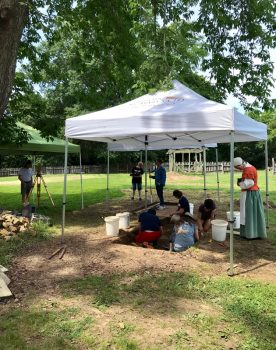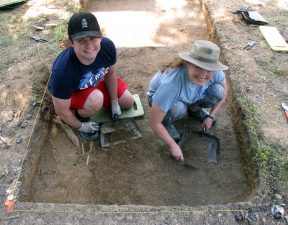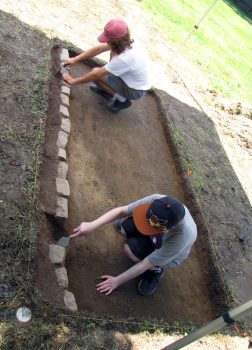Back to Dispatches from Field School
Field School 2018 – Week 2
Jade Arnold — George Mason University
“Beginning to Dig”
The second week of the 2018 season ended with us gaining a more complete understanding of the artifacts commonly found on the Calvert site and of excavation-related techniques. The first two days focused upon learning the features of various common artifacts so that we could properly place any that we find in their context.
These artifacts included “pleasure wares” (pipes and drinking vessels) and prehistoric artifacts. We learned about the evolution of smoking pipes and drinking vessels within the colonies from the 1600s to the early 1900s. We were then taught how to identify pre-historic artifacts as far back as 11,000 BCE. This helped to give us a better sense of how much history there is in this area, something that we will be able to share with visitors later on.
We were given a lesson revolving around the environment as well, in which we learned about how to accurately describe the soil. This is important because future archaeologists can look at these descriptions and compare them with how the area currently looks and deduce the cause for any discrepancies. After this, we learned about architectural remnants, such as nails and tile fragments. Nails can be particularly hard to identify, as they look very similar to small twigs when dirty.
During the next three days, we returned to the field. There was still much of the gravel left from the old driveway, making the excavation somewhat longer due to the extended amount of time needed when screening dirt. There was a mysterious line of stone blocks discovered in four units, which has raised some questions about its function. We took turns excavating and learning about how to use a total station. This is an instrument that allows one to find the position of a place in relation to another coordinate so that archaeologists can accurately record distances. Some students started working on an unexcavated unit; they were able to reach past the grass and get closer to the depth the other students had reached in their units. Students working in unit 1105 had pictures taken of their unit to document the stone block feature and were taught about unit drawings and how to record features.
Unit drawings provide a simple look at how the layer looks when cleared. This allows others to see what happened from layer to layer so that the information is not lost during the destruction of the unit’s stratigraphy. We were also able to see a variety of wildlife within the site, which gives us an appreciation of the nature that surrounds us alongside the history.




